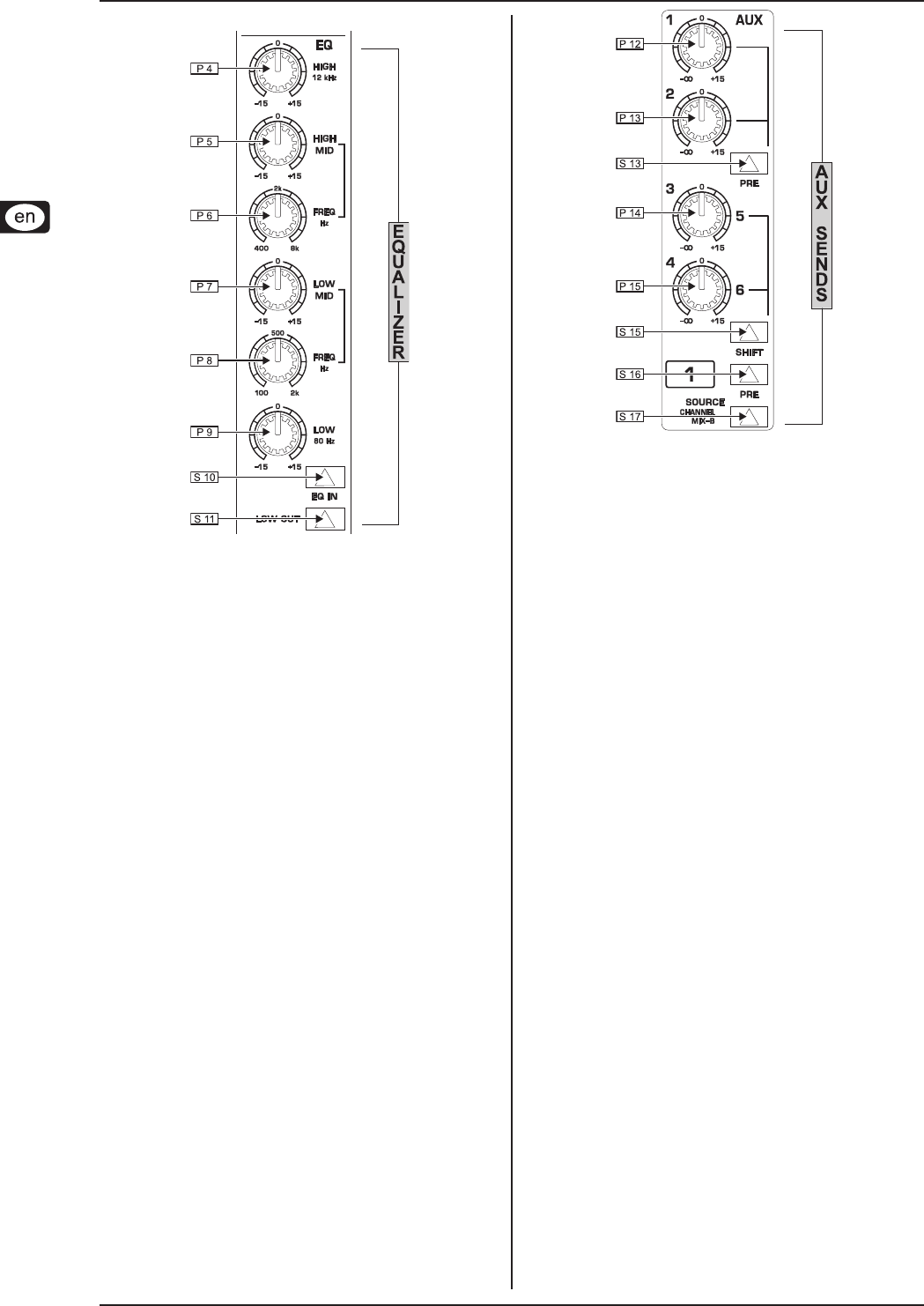
EURODESK SX4882
Input/output channel6
Main equalizer3.4
Main equalizerFig. 3.3:
The main equalizer can be switched (S10) out of circuit for easy
A/B comparisons between EQed and straight signals, or when
you know that you don’t want to use desk EQ at all. It is best
considered in three sections. First, there are two Baxendall
shelving frequency controls for treble and bass, at 12 kHz and
80 Hz respectively (P4 and P9). These are DUPLICATED for the
B-channel (P18 and P19), not merely “SPLIT” off from the main
EQ. I.e. you can have a full 4-band EQ on the main channel AND
a 2-band EQ on B-channel.
Secondly, there are two semi-parametric swept mids, Q xed at
1, which cover the bands 300 Hz to 20 kHz and 50 Hz to 3 kHz.
An unusually broad frequency range is catered for, and there is
an enormous 3-plus octave overlap between the two mid bands
(P5, P6, P7 and P8). No experienced engineer will complain about
that! All four bands offer 15 dB of cut and boost.
Thirdly, there is a steep high pass (low cut) lter (S11), slope @
12 dB/octave, -3 dB @ 75 Hz, for reducing oor rumble, plosives,
woolly bottom end, etc.
Aux sends3.5
All six aux sends are mono and post EQ. They are switchable
PRE/POST fader in two banks (S13 and S16). For aux sends 1
and 2, two dedicated pots (P12 and P13) are used. These can be
taken from a point before or after the channel fader, i.e. PRE or
POST (S13). Aux sends 3 and 4, and 5 and 6 are serviced by two
potentiometers (P14 and P15). The SHIFT button (S15) determines
whether buses 3 and 4 or 5 and 6 are addressed. Also, these four
sends can be derived from the main mix or MIX-B, depending on
SOURCE (S17), and, as before, can be pre or post (S16).
Aux sendsFig. 3.4:
For almost all FX SEND purposes, you will want auxes +
to be post fader, so that when a fader level is adjusted,
any reverb send from that channel follows the fader.
Otherwise, when the fader is pulled down, the reverb
from that channel would still be audible. For CUEing
purposes, aux sends will usually be set pre fader, i.e.
independent of the channel fader (S13 and S16).
Most reverbs etc. sum up the left and right inputs in- +
ternally. The very few that don’t may be driven in true
stereo either by 1) 2 aux sends or 2) the MIX-B bus (see
section 3.7 “B-channel”).
There is +15 dB of gain on every aux send. Such a high +
boost is only appropriate where the channel fader is
set around -15 dB or lower. Here, an almost exclusively
WET signal will be heard. Previously, in most consoles,
such a wet mix required the use of a PRE setting for the
channel auxiliary send. This meant losing fader control
over the signal.
Routing and muting3.6
ROUTING means selecting which BUS you want a channel to
address. There are actually six stereo buses in the EURODESK
SX4882 (plus a stereo SOLO bus). The main mix bus is selected by
S32 (see gure 3.5), while the subgroups are selected by switches
S28 (for groups 1 and 2), S29 (3 and 4), S30 (5 and 6) and S31
(7 and 8). Odd and even numbered groups are selected via the
main A-channel PAN P24, as are the left and right mix buses.
(The sixth stereo bus is the MIX-B bus, with it’s own independent
pan control P20; see section 3.7 “B-channel”). Usually, only one
of S28 to S31 will be selected for a particular channel (See block
schematics).
An exception to this rule is when laying down voice +
takes. It is often convenient to have the mic channel(s)
routed to alt potential TAKE tracks simultaneously, since
you are often dropping in quickly between four or more
tracks. It means one less button press each time you
switch tracks.


















